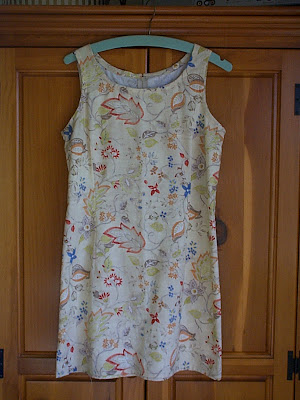We've already talked some about multi-color knitting created one color at a time--a kind of knitting called
multiple pass knitting. Now we're turning to the second category of one-color-at-a-time color knitting--SLIPPED STITCH patterns.
Slipped stitch patterns come in two flavors. First, simple slipped stitch. This kind mostly has a certain amount of contrast color and generous amount of the main color. The second kind are more complex patterns, often called "mosaic knitting." Complex patterns generally have roughly equal amounts of both colors.
click picture
SIMPLE SLIPPED STITCH color knitting:
A couple of decades ago, my mom made a multi-colored vest. While gearing up to write this series on color knitting, I dug it out. Mom never learned to knit with two colors at the same time, so I was curious how she'd made it. Looking carefully, that vest was made using a slip-stitch pattern--stitches from the row below (and sometimes, 2 rows below) were slipped up into the current row and left there. This created rows with two colors, although only one color was ever knitted at a time.
Below is a charted example: in this chart, row 4 is to be made by knitting the stitches shown in blue, and slipping the pink stitches indicated by the
red arrows.
click picture
Step 1 of this technique involves first knitting a blue stitch, then slipping a pink stitch, then knitting a blue stitch, and so on, down the line. This is the result on the needle: the slipped pink stitches are marked with a
red dot. (Below.)
click picture
Step 2: On the following row (row 5) all the stitches, both pink slipped and blue unslipped, are simply knitted. The slipped pink stitches (marked by a
red dot) remain in the fabric in their slipped positions. (Below.)
click picture
* * *

Simple slipped stitch patterns are probably the easiest of all methods for creating colored knitting. However, they are not to be scorned on that account. As the French philosopher
Descartes implied
(commentary to his third rule) when something is fine just as it is -- simple and evident -- it need not be wrapped in complications to make it seem more desirable and important.
See for yourself: this illustrations shows an extremely simple slipped stitch pattern; next to it is the quite gorgeous fabric which results.
Diagrams and instructions for all kinds of simple slipped stitch patterns are written up in pretty much any knitted fabric pattern book. However, because slipping stitches distorts the fabric (bunch it up, lengthwise) these fabrics are denser than regular one-color knitting -- sometimes a LOT denser. So, take that into account before you get seduced by the pattern book's riches.
One more thing to take into account: if you want to make two color slipped stitch fabrics working back-and-forth, it will sometimes happen that your two colors of yarn will wind up on opposite edges of the fabric. This is more of a surprise than a problem--the solution is laid out in the
green paragraphs about "out of phase yarns" in
this post (scroll down for the
green text).
 COMPLEX SLIPPED STITCH color knitting:
COMPLEX SLIPPED STITCH color knitting:The simple slipped stitch fabrics illustrated above generally involve slipping a few contrast stitches over a ground of main color. Complex slipped stitch patterns are made the same way--by slipping stitches of one color on the first pass, or the first several passes, then knitting these slipped stitches on a future row. However complex patterns differ from simple patterns:
- they are generally geometric
- they generally feature rather equal amounts of both colors
- the stitches are more frequently (but not always) slipped over more than one row.
Complex slipped stitch patterns knitted in motifs are often called "mosaic knitting" and their most famous proponent is Barbara Walker. Ms. Walker's book by that name was recently re-issued by
Schoolhouse Press, a service to knitters everywhere.
Mosaic knitting--whether in motifs or in all-over fabric--creates a firm, not very stretchy fabric, more like fabric woven on a loom than fabric created with knitting needles.
(This is because the high number of slipped stitches take most of the "reserve" out of the normally loopy knitted stitches--for more information on how knitted fabric works, follow this link.)

All-over mosaic fabrics; heck, any mosaics, have a retro look. They are rather thick and heavy -- best for outerwear or sleeveless garments. How 'bout this dapper gent's vest pattern from
Vintage Purls?
(VP, posting from Kiwiland--New Zealand --collects vintage patterns and puts them on the web for free. Thanks VP!) How 'bout those colors in the fabric sample knitted from the pattern? Do they scream 70's appliances to you? Me too.
Sock patterns are sometimes written in mosaic patterns, but even if made up in thin yarn, such socks would be heavy and inflexible--possibly better for hiking than for dress up.
--TECHknitter
(You have been reading TECHknitting on: Slipped stitch color knitting)













































